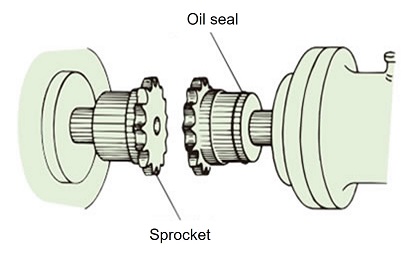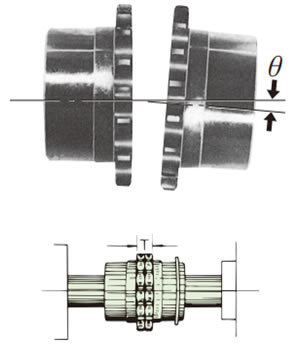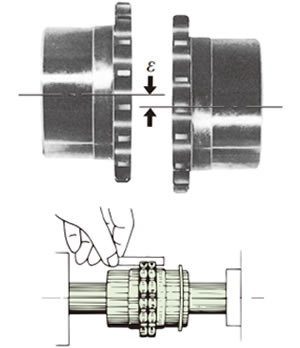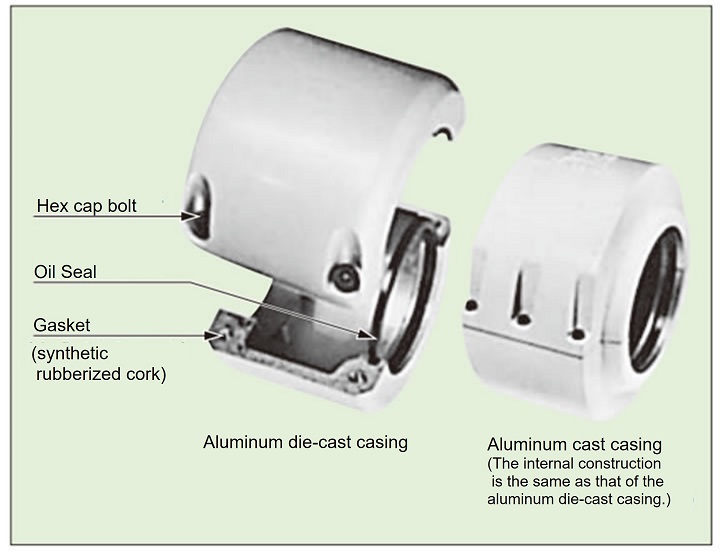Technical Data Coupling Handling
Roller chain coupling Handling
-
1. Fit the oil seal onto the right or left sprocket with the seal’s lip oriented toward the teeth.
(When using the coupling in a vertical orientation, attach the oil seal to the top sprocket. )
-
2. Bring the sprocket side faces into contact with each other and correct their angular misalignment and parallel misalignment.

Correct the angle so that tooth side face dimension T is equal around the circumference.
Allowable angular misalignment θ = No more than 1°
Place a straight edge on the tooth bottoms and adjust to eliminate any misalignment between them
Allowable parallel misalignment (Parallel Misalignment ) ε = No more than 2% of chain pitch (see values in table below )When operating the coupling at a speed of at least one-third the maximum rotation speed given in the transmission capacity table, use allowable mounting error values of θ = 0.5° or less, and ε = 1% of chain pitch or less.
- 3. Separate the sprockets by a distance equal to dimension S (given in the table of dimensions), and fasten the sprockets in place with set screws.
-
4. Fill the dimension S gap between the sprockets with grease, and also apply grease to the teeth.
Apply grease to the chain next, then wrap the chain onto the sprockets and fix with the joint pin. Insert the joint pin from oil seal side and confirm that the clip or cotter pin is securely fastened at counter oil seal side.

-
5. If using the case, fill both sides of the case with the specified amount of grease, and use the bolts to firmly attach both sides of the case to the sprockets.
A small amount of grease leakage will occur at the start of operation but will soon stabilize. If leakage doesn’t stop, check for attachment problems.
| Model No. | CR3812 | CR4012 | CR4014 | CR4016 | CR5014 | CR5016 | CR5018 | CR6018 | CR6022 |
|---|---|---|---|---|---|---|---|---|---|
| Allowable parallel misalignment
(Parallel Misalignment ) (ε) mm |
0.19 | 0.254 | 0.254 | 0.254 | 0.318 | 0.318 | 0.318 | 0.381 | 0.381 |
| Allowable angular misalignment
(Angular Misalignment ) (θ)° |
1 | 1 | 1 | 1 | 1 | 1 | 1 | 1 | 1 |
| Allowable end play
(Axial Displacement ) mm |
S±0.31 | S±0.68 | S±0.68 | S±0.68 | S±0.88 | S±0.88 | S±0.88 | S±1.02 | S±1.02 |
| Model No. | CR8018 | CR8022 | CR10020 | CR12018 | CR12022 | CR16018 | CR16022 | CR20018 | CR20022 |
|---|---|---|---|---|---|---|---|---|---|
| Allowable parallel misalignment
(Parallel Misalignment ) (ε) mm |
0.508 | 0.508 | 0.635 | 0.762 | 0.762 | 1.016 | 1.016 | 1.270 | 1.270 |
| Allowable angular misalignment
(Angular Misalignment ) (θ)° |
1 | 1 | 1 | 1 | 1 | 1 | 1 | 1 | 1 |
| Allowable end play
(Axial Displacement ) mm |
S±1.32 | S±1.32 | S±1.52 | S±2.02 | S±2.02 | S±2.52 | S±2.52 | S+1.0/-3.0 | S+1.0/-3.0 |
- Note) 1. Each allowable error is acceptable on the condition that other errors are all zero.
- Note) 2. When operating the coupling at a speed of at least one-third the maximum rotation speed given in the transmission capacity table, use allowable mounting error values of θ = 0.5° or less, and ε = 1% of chain pitch or less.
Notes for use
- 1. When using the coupling for applications involving high rotary speeds or extreme vibrations, always apply a thread locking fluid to the bolts before mounting the case.
- 2. Install a fixed cover in readiness for loose bolts, case damage or chain breaks.
- 3. Before removing the chain for installation or inspection, check that the equipment load side will not become dangerous when freed.
- 4. Inquire for information when using the coupling in an atmosphere not permitting grease leakage.
- 5. Always read the information in the user manual before starting installation or inspection work.
Case Structure and Function
The case is a split type that can be disconnected in the direction perpendicular to the shafts for handy mounting and inspection. The boss fitting holds the boss firmly and is precision-finished to ensure no parallel misalignment.
The hole on the other side is a trapezoidal groove in which an oil seal is placed to prevent oil leakage. It holds the sprocket boss freely to prevent loss of coupling flexibility.
The split joint encloses a gasket to make it oil-tight, and is fastened by bolts.
Attaching a case to a chain coupling prevents lubricant spraying and dust from entering, enabling complete lubrication that extends the coupling’s service life significantly. The case also protects the coupling from corrosive atmospheres, prevents hazards and improves appearance.
Inquire for information when attaching a case if the coupling will be frequently started/stopped, or subject to large amounts of vibrations.
Please mount a casing in the following cases,
- (1) Used at high rotating speeds.(See the transmission capacity table. )
- (2) Used under abrasive conditions, such as dusty areas.
- (3) Used in corrosive environments, such as moist areas.


